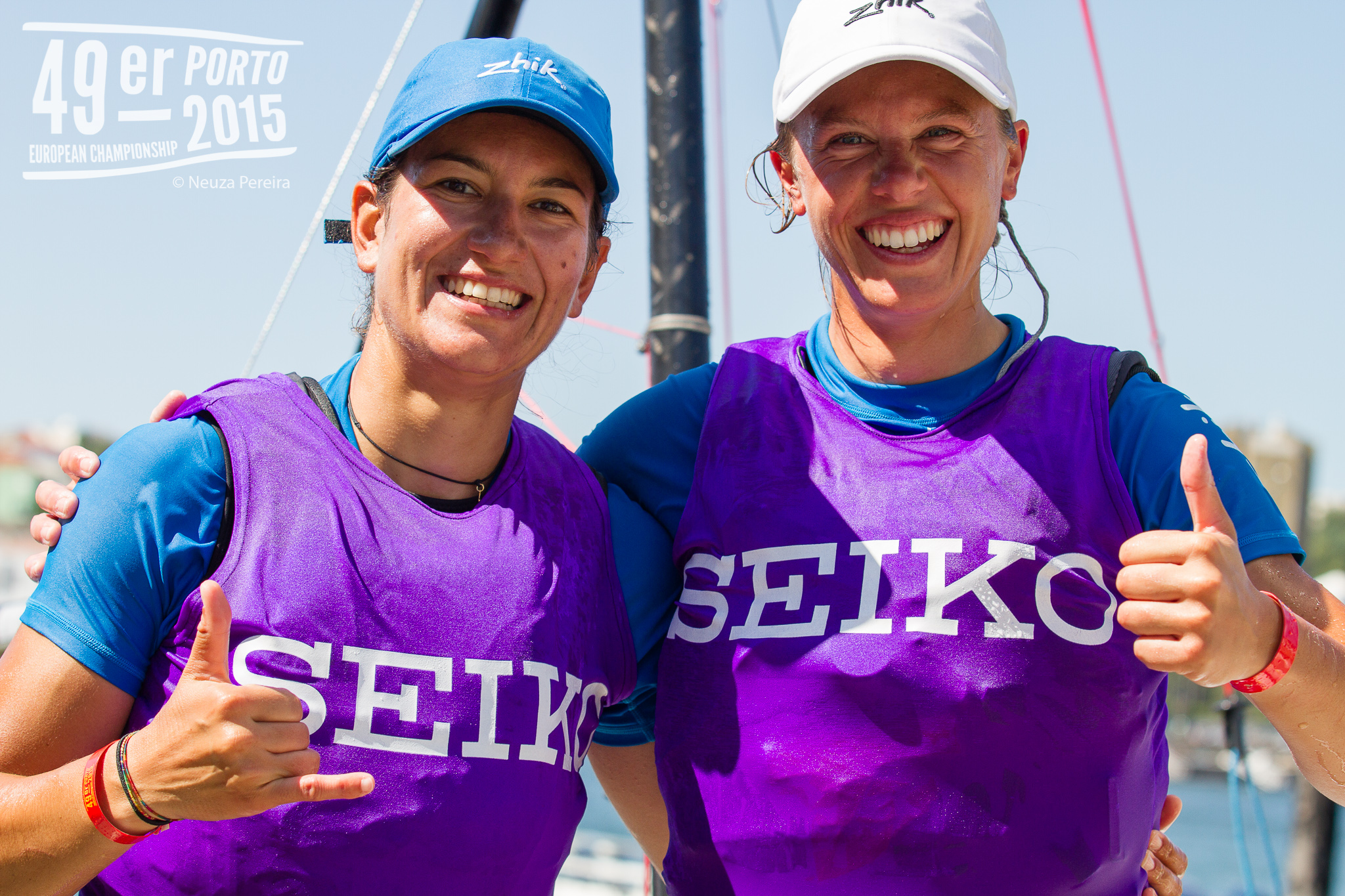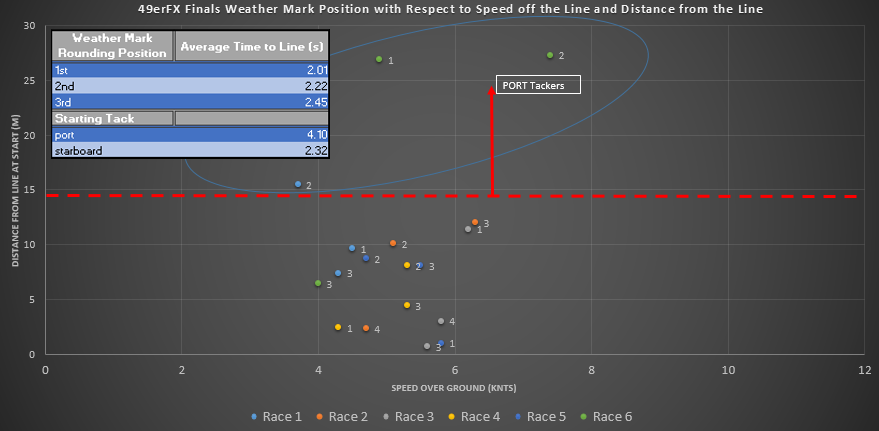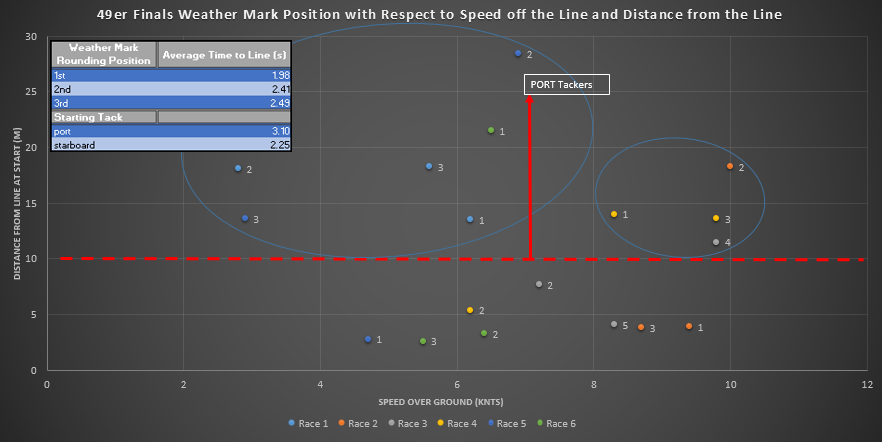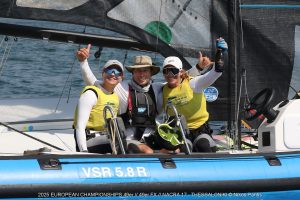The 2015 49er and 49erFX European Championships in Porto came to a close today with the Magic Marine Starting Competition and Seiko King of the Downwind for the 49ers.
Yesterday’s winners in the 49erFX fleet was the pairing of Nielsen/Olsen (DEN 2) who came back with a set of impressive starts following a DSQ in the first race. Although they were out-dueled by their countrymen Hansen/Salskov-Iversen ( DEN 71) on the start line, the award was chosen to be given to a team not on the podium. For the 49ers, the Polish team of Januszewski/Nowak (POL 52) owned the start line with an edge over the second place team of Alonso/Alonso (ESP 46), gaining the right to wear the green bib on the final day of competition.
In today’s action, the overall starting winner was Pink/Bithell (GBR 6), who consistently went off the line on port which seemed to frequently pay for the fleet. Despite this, the Magic Marine Starting Competition winner for today is the Germans Heil/Ploessel (GER 12) with a number of impressive starts and a bullet in the first race of the day. Similar to yesterday’s 49erFX winner, this was chosen as they were the top boat that didn’t reach the podium.
A full recap of scoring for the 49er fleet is as follows:
The Seiko Kings & Queens of Downwind award is based purely on the time spent sailing downwind. The individual downwind legs in all of the races are summated to work out who in theory sailed best downwind over the entirety of the regatta. It is no surprise that in both fleets, the least amount of time spent on the downwind was by boats at the front of the pack.
During yesterdays racing, the fastest pairing not on the podium of Ruskola/Cedercreutz(FIN 101) were awarded the Queen’s of the Downwind for the 49erFX fleet. For the men, Lange/Lange (ARG 133) were on top for a second consecutive day with a buffer of 24 seconds of lead time to bring into the final day of competition for the 49er’s.
The overall regatta winners Burling/Tuke (NZL 1) came from third place in yesterdays downwind competition to take the overall fastest boat downwind title. This comes as no surprise after their dominant performance throughout the three races today. It was however decided that the team of Lange/Lange (ARG 133) are the Regatta’s Kings of the downwind given their absence on the podium yet consistently fast downwind performance over the last three days.
Complete Seiko Downwind results are found below:
Regatta Starting Analytics
Yesterday, following the conclusion of racing in the women’s fleet, came the chance to sift through more detailed stats provided by the SAP Analytics. Of interest was the relationship between distance to the start line and boatspeed at GO with the boat’s position at the first weather mark. Without creating the graph, it can easily be postulated that good boatspeed close to the line, will generally tend to produce better results at the windward mark.
The plots below for both the 49er and 49erFX is of the first three boats that reached the weather mark during each race, and their subsequent speed and distance at the line. At first glance there doesnt’t appear to be any strong correlation between these metrics. In both graphs, there are a number of outliers (circled in blue) which seem to show counter intuitive results to the mindset that a fast,clean start will yield better positioning. When the outlying points are viewed in real time with the SAP Tracker, it can be seen that all were produced by port tack flyers. This goes to show the variation of strategy which can be chosen at the line or sometimes is adopted in a last minute act of desperation to get out of a tight spot. In the case of the 49erFX, if a boat was hitting the line on a port tack, generally they had a greater run up distance and were often carrying more speed at the time of GO. This was also observed in the men’s fleet although they often times had a smaller distance to the line and were, on average, carrying more speed while on port. This is shown by the red hashed lines which highlight the minimum distance to the line at the start. In the case of the 49erFX fleet, the minimum gap to the line was 15m while the 49ers had a minimum of 10m. The large distances from the line in both fleets can most likely be attributed to the port-starboard interaction along the line and the need for port boats to pick their spot along the line carefully while always avoiding the majority of the fleet on the opposite tack.
The difference in terms of speed and distance from the line between the two fleets can be chalked up to either increased aggressiveness and risk allowance in the 49ers or the volume of boats which decided to start on port during each race. Upon looking a each start, it is apparent that it may be a mix of both reasons. In the women’s fleet, there was often a greater split off the line, leading to more boats on starboard at the gun. As was previously discussed, this leads to a more uncertain start for any port-tackers and an increased degree of conservatism. In the case of the men’s fleet, often times the majority of the fleet would start on port if it was viewed as the favored tack. This led to some of the best starts of the day being from these boats. For example in the 1st race of the day, Heil/Ploessel (GER 12) blasted off the line on port, in an extremely clear lane to shoot a bullet in the race. This pairing’s good results also support my first statement on risk allowance. Coming into the final day, they knew to post a good result, they would have to push a little harder. When this creeps into a teams strategy, often times you see more aggressive behavior on the start line. It’s these two reasons which also explains the two circled regions on the 49er plot. Within each highlighted area, the points are from distinct races which don’t overlap. When the race is played back using the SAP Tracker, it can be seen that in races 2,3,4, the fleet had a tendency to be on port off the line. This led to smaller run up distances with greater speeds (as seen in the plot). During races 1,5,6, a large amount of boats were still starting mid-line to pin-end on starboard, leading to a more congested line. As a result, any port tack flyers had less options at un-obstructed lanes.
The table which overlies both plots show the average time to the line after the gun goes, for the first, second and third placed boats at the weather mark. This isn’t exact as it accounts for speed over ground and not VMG which would actually be more indicative. Despite this, it does still show the distinct trend between a good start and an early rounding after the first leg. This relationship is further stretched into looking at all port tack vs starboard stack boats crossing the line. On average starboard tack boats held almost a 2 second advantage in the 49erFX fleet in comparison of less than a second for the 49ers. This once again demonstrates the difference in aggression and volume of boats on port between the men’s and women’s fleet. The use of pseudo “time to line” is a great way of showing this as it accounts for both the distance from the line and speed within the same value.
The results from both gold fleets play well into getting a glimpse of pre race tactics and how they evolve over not only a single starting sequence but also the regatta as a whole. As a boat on starboard tack, as long as a clear lane is found, they are essentially in control of the quality of their start in terms of hitting the line at the right time with maximum velocity. As a port tacker, it’s not hard to imagine that the run up to the line is far more uncertain and generally results in less than ideal starting positioning. However, if the decision to start on port is the right one, then it may pay dividends by the time you reach the windward mark. This thought process was interesting to follow throughout the races as even when the port tack was lifted and course right was far more breezy, some boats decided to remain on starboard tack off the pin due to course scew or desire to ensure a clean start. On the races where the fleet was mostly starting on port, they were often the first to reach the top of the course as a result.
As often is true in the sport of sailing, things aren’t always as they first appear. From an initial look at the results, there isn’t a clear relationship between starting performance and place at the windward mark. When you take a step back and begin to questions this, it becomes apparent that the amount of variables in play at the start line is almost endless. It’s at this point where you must look mostly at what other boats are doing in relation to you and how to react to that. Often times in the case of each of the fleets, that move was to split on port to take advantage of more favorable winds on an often lifted tack. It’s decisions to sacrifice some performance off the start line in pursuit of more favorable sailing conditions on the course which is the hardest to make as a young sailor. However, as Peter Burling and Blair Tuke showed throughout the regatta, to be an elite sailor, this type of vision is needed.











